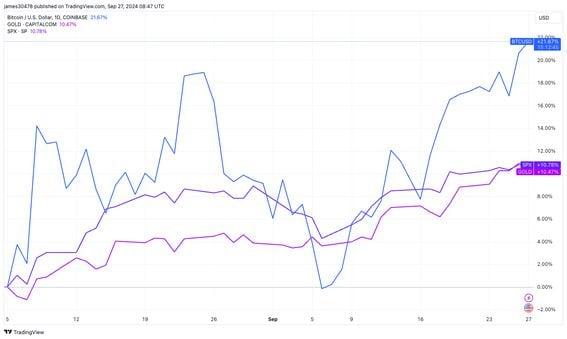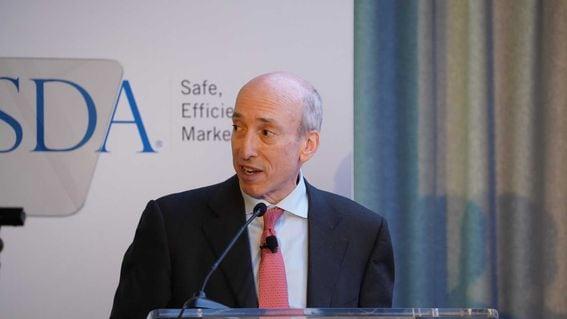2024-09-27 11:00
FLOKI tokens could see a price jump as the project’s closeness to GraFun boosts fundamentals. GraFun, a new memecoin launchpad and trading platform on the BNB Chain, is set to launch on September 27, 2024, at 11 am UTC. It introduces a "Fair Curve" mechanism aimed at promoting fair launches and long-term investment in memecoins. GraFun has garnered support from significant players in the crypto ecosystem, including Floki, BNB Chain, DeXe Protocol, HOT Protocol, and strategic partnership with DWF Labs. Floki will own 40% of GraFun, expecting to leverage this to enhance its influence in the BNB Chain memecoin market - boosting the project’s fundamentals. The memecoin issuing and trading frenzy that gripped Solana and Tron blockchains in the past few months could soon see a repeat on the BNB Chain ecosystem, thanks to a protocol that says it is making the process easier and better for users. GraFun, a memecoin launchpad and trading platform exclusive to the BNB Chain network, will be released on September 27 at 11:00 UTC. It uses a unique bonding curve mechanism that allows anyone to fairly launch a memecoin for next to nothing. This is similar to Solana’s runaway hit Pump Fun, but GraFun’s developers say they have made certain key improvements. “It's all about promoting long-term investment and real growth,” GraFun developers explained in an X post. “Unlike the traditional bonding curve, the Fair Curve is community-first. And built to benefit everyone who participates. It gives you the power to be part of a DAO — where decisions are made by you and your fellow token holders.” The project has bagged support from crypto ecosystem project Floki and other industry heavyweights including BNB Chain, DeXe Protocol, and HOT Protocol. DWF Labs is also a strategic partner. “Floki is the biggest memecoin brand on the BNB chain by far, and our role in helping with its recent launch and ensuring its success has shown the kind of sway Floki holds within the BNB ecosystem and in this space as a whole,” Floki developer B told CoinDesk in a message. “With Floki’s backing, GraFun will send a strong message to the industry that it is the de facto platform for creating fair launch memecoins in the space,” B added. Floki will receive 40% ownership of GraFun and get 40% of the revenue generated from the launchpad. Floki’s ownership of GraFun will lead to key benefits for FLOKI and its sister project TokenFi (TOKEN), developers told CoinDesk in a release. What is bonding curve model? With the bonding curve model, anyone can deploy a memecoin or a launchpad that supports this model for next to nothing (e.g., anyone can create a memecoin with GraFun with a few dollars or less), with zero developer experience and without having to make any form of commitment (liquidity, expensive token deployment costs, etc). The memecoin launchpad then allows the market to determine the value of the memecoin: if there is enough demand to push the memecoin to a certain market cap (e.g., $100,000 market cap), it hits a “bonding curve,” and liquidity is automatically added to a decentralized exchange (DEX) and burned or locked - making it possible for anyone to buy the memecoin on DEXs. If a memecoin does not hit the bonding curve, it simply does not get “launched” on a DEX. The memecoin launchpad makes money regardless. The most popular examples of memecoin launchpads that use this kind of model are Pump on Solana - which pioneered such a model - and Tron’s Sun Pump. Pump.fun has made over $110 million in fees in the last 6 months alone and is currently projected to generate $136.5 million in annual fees. SunPump has made $5.2 million in fees since launching a little over a month ago and is currently projected to generate $51.8 million in annual fees. However, the massive amount of tokens launched on Pump and Sun means most tokens fail to reach a bonding curve and end up in losses - leaving a majority of users unhappy in the past months. As CoinDesk previously reported, Pump's quick token creation services mean tens of thousands of tokens have likely been issued since its March launch. However, only a few have reached more than $10 million in market capitalization. GraFun’s USP is the “Fair Curve” model, which developers say minimizes rug-pull risks, reduces price manipulation, and ensures fairer token issuances that result in fewer users losing money. https://www.coindesk.com/tech/2024/09/27/grafun-supported-by-floki-and-dwf-labs-brings-memecoin-frenzy-to-bnb-chain/

2024-09-27 09:51
BlackRock's latest report shows that bitcoin has a very low correlation to U.S. equities on a trailing six-month basis. Bitcoin is up 22% since the Yen carry trade unwind on Aug. 5, while gold and the S&P 500 are up around 11%. Over 65% of the circulating bitcoin supply has remained unmoved for over a year. Almost all holders are in profit if they held for three years, while they are all in profit if they held for at least five years - Unchained. BlackRock released a report last week, titled "bitcoin as a unique diversifier." The investment giant identified four key points from the report. First, how to analyze bitcoin (BTC) in relation to traditional financial assets due to its fundamental properties, such as not having a quarterly earnings report or a CEO. Second, bitcoin's high volatility can be perceived as a "risky" asset, which contributes to the discussion that whether it is a "risk-on" or "risk-off" asset. The token could be considered a flight-to-safety option because it is scarce, non-sovereign, and decentralized. Lastly, BlackRock pointed out that the long-term adoption of bitcoin may come from global instability. Bitcoin's realized volatility trends downwards Bitcoin's realized volatility continues to trend downwards over time, indicating increased stability. In the early years of bitcoin, its realized volatility used to trade over 200%; however, as the asset matured, so did the volatility. Since 2018, realized volatility has not exceeded 100% and is currently at 50%. As realized volatility decreases and liquidity increases through financial instruments such as the spot and futures market, this may bring in more sophisticated investors such as options traders. This seems to be on the horizon with the U.S Securities and Exchange Commission's (SEC) approval of physically settled options tied to BlackRock's spot bitcoin ETF. Risk-on or risk-off? BlackRock also asked the question: Is bitcoin risk-on or risk-off? While short-term trading may suggest that bitcoin behaves like a risk-on asset, the data reveals a different narrative over a longer time horizon. According to data from bitcoin custody service Unchained, "almost all holders (99%+) are in profit if they held for just three years. All bitcoin holders in this class are in profit if they held for at least 5 years". We can see this type of mentality on-chain among investors, where over 65% of the circulating bitcoin supply has remained unmoved for more than one year, according to Glassnode. This trend suggests that many investors tend to hold bitcoin because they believe in its store-of-value narrative and view it as a risk-off asset, even though bitcoin has faced multiple 20% corrections in 2024. Low historical correlation with U.S equities BlackRock also showed that bitcoin has a very low correlation to U.S. equities. A graph shows the trailing 6-month S&P 500 correlation with bitcoin; the average correlation is 0.2 since 2015. Sometimes, assets will trade near one-to-one with one another due to external macro factors, most likely in risk-off or liquidity events. The report notes, "These episodes have been short-term in nature and have failed to produce a clear long-term statistically significant correlation relationship." Bitcoin outperforms other risk-on assets after major events Continuing with the theme of having a long-term time preference, BlackRock noted that bitcoin tends to outperform other risk-on assets after 60 days following a major geopolitical event. The U.S.- Iran escalation in 2020 saw bitcoin return 20% after 60 days, outperforming gold and S&P 500. This was also the case for Covid-19, the 2020 U.S. election challenges, the Russian Invasion of Ukraine, the U.S. regional banking crisis, and most recently, the Yen Carry trade unwind on Aug. 5. During the recent Yen carry trade unwind on Aug. 5, which was now 53 days ago, major assets experienced declines on the day. However, bitcoin has risen by 22% since then, with gold and the S&P 500 up roughly 11%. https://www.coindesk.com/markets/2024/09/27/blackrock-highlights-bitcoins-unique-properties-believes-btc-is-risk-off-in-the-long-term/

2024-09-27 09:49
Thursday's bullish trading range marks an end of the recent consolidation and a resumption of the rebound from lows under $53,000. Bitcoin's widening trading range and a move above the August high suggests more gains ahead. The six-month corrective trend in altcoins seems to have ended. Earlier this week, analysts at the Bitfinex crypto exchange said August's $65,200 high is the level to beat for bitcoin (BTC) bulls. The breakout happened Thursday and how. Bitcoin jumped over 3%, the most in nine days, to the highest since July 31 with a wider trading range than Tuesday, according to charting platform TradingView. In other words, the cryptocurrency formed a bullish "outside day" pattern, signaling an end of the recent consolidation below $65,000 and a resumption of the rally from lows under $53,000. "The outside day can form midway in a price trend, just like flags and pennants. Since outside days act as continuation patterns, expect the breakout to be in the same direction as the inbound price trend," investor and technical analysis expert Thomas N. Bulkowski wrote in his book "Encyclopedia of Chart Patterns." The breakout flipped the August high into a support level, shifting focus to the next resistance closer to $70,000. The resistance is identified by the trendline connecting highs registered in March and June. Bitcoin has gained almost 1% so far on Friday, close to $66,000, validating the bullish breakout. The positive bias would be invalidated if prices fell below Thursday's low of $62,805. Altcoin breakout While bitcoin is still stuck in a broad descending channel, the cumulative market capitalization of alternative cryptocurrencies (altcoins), or tokens other than market leaders bitcoin and ether, has broken out of a six-month corrective trend. The breakout points to a potential "alt season" ahead, a period characterized by smaller tokens outperforming BTC and ETH. https://www.coindesk.com/markets/2024/09/27/bitcoins-outside-day-sets-stage-for-70k-altcoins-break-out-technical-analysis/

2024-09-27 09:30
A Federal Bureau of Prisons rule states that an inmate whose release date falls on a Saturday, Sunday, or legal holiday, may be released on the last preceding weekday. CZ was sentenced to four months in prison in April after pleading guilty to violating the Bank Secrecy Act by failing to set up an adequate know-your-customer (KYC) program at Binance. "We are delighted that CZ will be home with his family. While he is not managing or operating Binance, we are excited to see what he does next," a Binance spokesperson said. Binance founder Changpeng “CZ” Zhao, could be released on Friday, two days ahead of his scheduled release date of Sept. 29th (Sunday), according to an interpretation of the law. The U.S. Department of Justice's Federal Bureau of Prisons rule states that "The Bureau of Prisons may release an inmate whose release date falls on a Saturday, Sunday, or legal holiday, on the last preceding weekday unless it is necessary to detain the inmate for another jurisdiction seeking custody under a detainer, or for any other reason which might indicate that the inmate should not be released until the inmate's scheduled release date." The decision may depend on the discretionary authority given to Wardens. The Bureau of Prisons did not immediately respond to a request for clarification and comment sent outside of office hours from CoinDesk. CZ was sentenced to four months in prison in April after pleading guilty to violating the Bank Secrecy Act by failing to set up an adequate know-your-customer (KYC) program at Binance. If released on Friday, CZ would have spent 116 days in prison. He spent three months at a low-security prison, Lompoc II, on California’s central coast before being moved to a halfway house in San Pedro, California in late August. "We are delighted that CZ will be home with his family. While he is not managing or operating Binance, we are excited to see what he does next," a Binance spokesperson said. "Since last year, Binance has continued to thrive under the leadership of our current team, surpassing 230 million users globally." Read More: CZ’s Trial Proves It Pays to Cooperate https://www.coindesk.com/policy/2024/09/27/binance-founder-changpeng-cz-zhao-could-be-released-on-friday/

2024-09-27 07:58
TIA has outperformed the CoinDesk 20 Index by a wide margin. TIA has outperformed the CoinDesk 20 Index this month by a large margin. There has been an increase in TIA hedging demand ahead of a Oct. 30 token unlock, Wintermute said. Bearish short positions, likely representing hedging, have been crowded out, funding rates suggest. TIA, the token of data-availability blockchain network Celestia, posted its best monthly gain this year, outperforming the broader market by a significant margin and confounding traders who'd positioned for a drop in the price as the result of a $1.13 billion token unlock due next month. The market-beating 40% surge, the biggest since December 2023, contrasts with a 13% gain in the CoinDesk 20 Index, a measure of the largest, most liquid cryptocurrencies. It takes place against a background of some market participants seeking downside hedges due to concerns the massive token unlock due Oct. 30 will flood the market and depress prices. Next month's unlock will release 175.74 million TIA. That's 16% of the cryptocurrency's total supply and worth $1.13 billion, or 82% of the market capitalization, according to data source CryptoRank. Such large unlocks often create bearish pressures in the market. "There has been an uptick in TIA hedging demand ahead of the Oct. 30 unlock – both via exchange-traded perpetuals, alongside OTC forward agreements with market makers/trading desks," Jake Ostovskis, an over-the-counter trader at Wintermute, told CoinDesk in a Telegram chat. Short squeeze The bias for shorts, likely stemming from the hedging activity, might have led to a "short squeeze," contributing to the TIA rally. A short squeeze happens when the asset price remains resilient, contrary to expectations, forcing bears to close their positions, which are bets that an asset will drop. That, in turn, puts upward pressure on prices. "Traders tried to sell ahead of the [unlock] event from Julyish. I'd argue the squeeze has already happened," Ostovskis said. That's evident from the recovery in funding rates tied to TIA perpetuals, which have rebounded to nearly zero, or neutral, having been in negative territory since July. As suggested by Ostovskis, rates below zero are a sign of traders taking bearish bets to protect against the downside price risk posed by the influx of so many tokens. The recovery to neutral alongside the TIA price rally suggests shorts have been crowded out and might have inadvertently squeezed the price higher. The $100 million fundraise A $100 million fundraise announced this week likely gave bears another solid reason to exit shorts, adding upward momentum. The fresh round raised the foundation's cash stash to $155 million, although the team did not detail how it plans to use the funds. Some pseudonymous observers have suggested the fundraising was an OTC deal at a $3.4 billion valuation directly with the foundation, with the token sale priced at $3 and one-third of the same to be unlocked on Oct. 30. According to Ostovskis, the impending unlock may have been priced in. "Some commentators have seen their OTC sale sales as controversial, however, the result that a large cliff has been removed and enabling the pre-hedging unlocks has overall been positive, allowing the market to price in this event in advance," Ostovskis noted. 15:36 UTC: Correction: the token unlock is scheduled on Oct. 30 and not Oct. 31. https://www.coindesk.com/markets/2024/09/27/celestias-tia-posts-biggest-monthly-gain-this-year-even-as-impending-113b-token-unlock-spurs-hedging/

2024-09-27 06:48
Gensler was responding to CNBC's question on whether the SEC chair was "warming up to top-tier crypto?" SEC Chair Gary Gensler has once again said that bitcoin is not a security and that "you can actually express that view by buying ETF products now." Given its election season, Gensler refused to reveal his view on Donald Trump's plan to have a bitcoin strategic reserve for the U.S. "Not liking the rules is not the same as that there aren't rules," he said insisting that current laws give the SEC the power to oversee the crypto space. U.S. Securities and Exchange Commission (SEC) Chair Gary Gensler reiterated his stance that bitcoin (BTC) is "not a security" but doubled down on his stated position that regulatory clarity exists for the crypto space in an interview with CNBC on Thursday. "As it relates to bitcoin, my predecessor and I have said, that's not a security," Gensler said. "You now have a way that you can actually express that view — buy into that through exchange-traded products." Such products were approved by the SEC in January, marking a monumental shift in the agency's approach to the crypto space. Gensler was responding to CNBC's Joe Kernen asking whether the SEC chair was "warming up to top-tier crypto?" "Where are you on what's called altcoins, there's 15 or 20 thousand of them. Where are you Joe?" Gensler asked. Gensler refused to reveal a position on what he thought about Donald Trump's idea "to keep the current government holdings "as the core of the strategic national bitcoin stockpile." "I have a view but given my role and also we are in election season so for the listening public I will stick to my chalk lines which are securities markets and chairman Powell and others can speak to that." Apart from bitcoin, Gensler has maintained that the vast majority of other tokens fit the legal definition of securities that are rightfully under the SEC's jurisdiction. This position remains despite industry push back, lawsuits against the SEC and a recent hammering the SEC got for two hours during a congressional hearing titled "Dazed and Confused: Breaking Down the SEC’s Politicized Approach to Digital Asset." Asked by CNBC if the SEC had been regulating by litigation, Gensler once again argued that current laws give his agency the power to oversee the crypto space. "Not liking the rules is not the same as that there aren't rules.” Gensler also said that he didn't know where bitcoin will be in 20 years but that that he felt "the field is going to have a challenge building trust" which it is "already" when "there's so many fraudsters, scammers." "Look at the leading lights in this field, in the crypto field just two years ago. A number of them are in jail right now, and I'm not just talking about SBF... there's been tens of billions of dollars of losses and bankruptcies and so forth," Gensler said on Thursday. "What innovative field in America survives without having building trust in that field and protecting investors or consumers?" Binance founder Changpeng “CZ” Zhao, who is currently serving a four-month prison sentence, will be a free man by the end of this week. Read More: SEC’s Crypto Record Rebuked by Ex-Commissioner, GOP Lawmakers in Hearing https://www.coindesk.com/policy/2024/09/27/secs-gensler-wont-reveal-his-view-on-trumps-bitcoin-reserve-reiterates-bitcoin-isnt-a-security/
